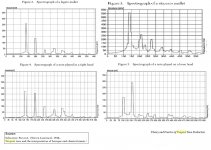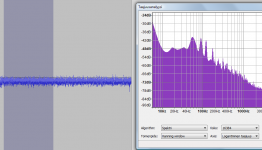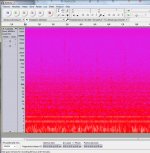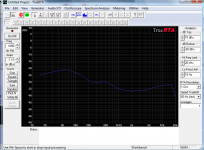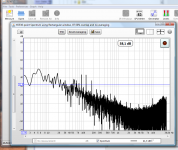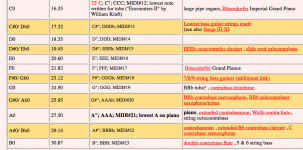Well, (Jahazi) the 50Hz is clearly a/c line noise, maybe from the within the measurement setup, maybe from lighting/etc., maybe both. As for the really low stuff, it is kind of unlikely you have a setup that can actually measure below 20Hz, but feel free to correct me if you do.
DrDayna, considering the lowest "natural" note is 32 Hz, what are you listening to? I might want to have something like that for a reference as I don't care for heavy organ. If it is electronic though, I'll pass.
B0 on a 5-string bass or a normal double bass is 31Hz.
That'd also imply an A0 note, which IIRC is ~28Hz.
Its rare to see anything tuned that low, as most systems won't reproduce it anyway.
Some of the larger pianos would do it (and probably lower, given enough strings).
What about tympani?
Chris
DrDayna, considering the lowest "natural" note is 32 Hz, what are you listening to? I might want to have something like that for a reference as I don't care for heavy organ. If it is electronic though, I'll pass.
Electronic.
Edit: But, should we consider this "un-natural"? Just because some musicians carve their instruments out of computers instead of wood doesn't mean we shouldn't evolve our thinking about music. Good thing we've evolved at least as much as we have, if we had this discussion before the invention of musical instruments, some of you might be making the argument that we don't need a speaker that plays any lower than a person could sing.
Then someone decided it would be cool to hollow out a tree trunk and beat on it with a stick...and ever since then, we've been chasing that feeling.
This is what one of my earlier comments hinted at, where a lot of people form opinions about what's necessary based on prejudice about music and artistry, what's real, what's fake, this is music, this is not, yadda yadda yadda.
If you're confined by your own musical taste, it'd probably be best to refrain from giving musical reproduction advice, unless the recipient of the advice is forewarned about the absolutely subjective nature of the advice.
Last edited:
B0 on a 5-string bass or a normal double bass is 31Hz.
That'd also imply an A0 note, which IIRC is ~28Hz.
Its rare to see anything tuned that low, as most systems won't reproduce it anyway.
Some of the larger pianos would do it (and probably lower, given enough strings).
What about tympani?
Chris
Chris
Timpani goes down to around 100 Hz.
It gives the acoustic impression of producing lower frequencies but this is due to it’s harmonics, which lead to the “missing foundamental”.
Musical instruments with low foundamentals
Frequencies
George
Attachments
Sat averaging ambient noise in my office. Don't see modes.
tvrgeek
I don’t know what the level of ~ -115dbu really means (what is your 0dbu?) but I guess that your office is really quiet, at least on low frequencies. For this, you’d better average more than 10x measurements to see the room modes.
The more noisy a space is, the more energy exists to excite the room modes and the less averaging is required.
e.g. The noise of a heavy vehicle passing through a nearby street, provides a broadband acoustic energy with changing frequency .
Room modes are strongly excited and remain excited at their set frequencies for some time, so that even x2 or x3 averaging will reveal them.
George
.
DrDayna, considering the lowest "natural" note is 32 Hz, what are you listening to? I might want to have something like that for a reference as I don't care for heavy organ. If it is electronic though, I'll pass.
I am not too far from a highway, and my sub-30 Hz noise is very high too. You don't notice it during the day, but if you sit out at night, the source becomes very clear.
I had this same problem. I used to live near a major interstate in Northern California. I also had a sub-30hz noise problem that could be best illustrated by setting a glass of water on any surface in that apartment. You could easily see the ripples in the water, even if you could not hear the traffic noise.
I am not suggesting electronic is not music, just not "natural Western scale" musical notes. Music is what the artist offers. We like it or not. If an artist is trying to woo an Elephant, than 10Hz is probably quite necessary. Listening to anything on a CD, nope. I also know a bit on how amps work, and understanding both the input DC blocking networks, feedback methods and/or DC servo, you are not producing 10 Hz anyway unless you built a very special amp to do so. No one here is arguing that a 30 Hz fundamental is not unreasonable. So understanding the roll-off of the woofer, what is necessary to produce 30 Hz? I use sealed subs with F3 of 25Hz and 25 Hz second order HP filters, so a 30 fundamental is a bit weak on my system considering I have a third order HP at 25, plus or minus the room. One of these days I may add a peaking filter (LT) to give the 30 to 35 that little extra touch. I am not sure the neighborhood would appreciate it though.
Watching my analyzer to Blackwood Night. Strong kick drum at about 50 Hz, It is showing significant energy to 10 Hz. Sub OFF. Tain't nuttin there but artifacts of how DSP works folks! My amp won't produce it, and my mic won't pick it up, and preamp won't pass it to the computer. Don't be fooled by a squiggly line on a computer if you don't understand what it is really measuring and calculating. FFTs only tell you what the calculation says, not the truth.
Watching my analyzer to Blackwood Night. Strong kick drum at about 50 Hz, It is showing significant energy to 10 Hz. Sub OFF. Tain't nuttin there but artifacts of how DSP works folks! My amp won't produce it, and my mic won't pick it up, and preamp won't pass it to the computer. Don't be fooled by a squiggly line on a computer if you don't understand what it is really measuring and calculating. FFTs only tell you what the calculation says, not the truth.
tvrgeek
I don’t know what the level of ~ -115dbu really means (what is your 0dbu?) but I guess that your office is really quiet, at least on low frequencies. For this, you’d better average more than 10x measurements to see the room modes.
The more noisy a space is, the more energy exists to excite the room modes and the less averaging is required.
e.g. The noise of a heavy vehicle passing through a nearby street, provides a broadband acoustic energy with changing frequency .
Room modes are strongly excited and remain excited at their set frequencies for some time, so that even x2 or x3 averaging will reveal them.
George
.
Fairly quite office. -80 maybe. The analyzer was peak hold of many minutes of 5X averaging. Scale is only relevant, not calibrated. Could be just not noisy enough to see any modes excited above ambient. I keep an old analog sweep generator for room testing. Great for finding things that don't behave. Back of china closet, center speaker, a spring bail in one window, and being sure the felt pads under all the paintings are doing their job. Also fun to see how dramatic the modes are as you walk around.
I may try low levels of noise to see what threshold starts to show measurable issues. If your idea is correct, I should see them rise out of the background.
I don't know what a -115 dB room would sound like. I believe the blood in your ears is considerably louder than that. You can hear it sitting in a quite mountain pass in the snow or in a cave quite clearly.
My methods were questioned. Seems to me that I'm the only one who is telling how they measure! Is this why I am under charge? My graph was meant to be a teaser for this discussion, not a "truth"
I quickly took new measurements with three different programs and this time the microhone is Microsoft LivCamHD. Yes, it has an amazing mic! I didn't even try to adjust levels.
Audacity graph is comparable to Zoom measurement, but location is different and this time the mic was lying on sofa (different place) Same position here in every measurement.
REW was set to C weighting.
Yes, i Can hear the ambient noise very well! The PC makes noise and air criculation system is on. Cars and trains are 600m away. Nobody was walking or talking in the house.
Can you set me free now? What about other peoples methods? I am not a scientist and I'll not spend money on a specific calibrated measuring microphone. I don't get paid for this and I don't own stocks of any AV company.
About measured responses and music - commercially produced music hardly ever contains signals <30Hz (noise at level of -70dB and less though) The speakers have trouble trying to put out those fQ and they have significant distortion then. Some of distortion is 1/2 of main Fq. Low sounds also excite the air, window panes, curtains, tables, paintings on the wall etc. They make resonances too. All this contributes to measurements done at listening site. This shoud be a well known fact, only the level of this noise is vague without some measurements of it! Every measurement gives slightly different results, because there are so many variables.
Have you ever heard of anechoid chambers? They have ambient noise too. You can't get away from it but you must know where and how much of it is.
Peace!
Juha
I quickly took new measurements with three different programs and this time the microhone is Microsoft LivCamHD. Yes, it has an amazing mic! I didn't even try to adjust levels.
Audacity graph is comparable to Zoom measurement, but location is different and this time the mic was lying on sofa (different place) Same position here in every measurement.
REW was set to C weighting.
Yes, i Can hear the ambient noise very well! The PC makes noise and air criculation system is on. Cars and trains are 600m away. Nobody was walking or talking in the house.
Can you set me free now? What about other peoples methods? I am not a scientist and I'll not spend money on a specific calibrated measuring microphone. I don't get paid for this and I don't own stocks of any AV company.
About measured responses and music - commercially produced music hardly ever contains signals <30Hz (noise at level of -70dB and less though) The speakers have trouble trying to put out those fQ and they have significant distortion then. Some of distortion is 1/2 of main Fq. Low sounds also excite the air, window panes, curtains, tables, paintings on the wall etc. They make resonances too. All this contributes to measurements done at listening site. This shoud be a well known fact, only the level of this noise is vague without some measurements of it! Every measurement gives slightly different results, because there are so many variables.
Have you ever heard of anechoid chambers? They have ambient noise too. You can't get away from it but you must know where and how much of it is.
Peace!
Juha
Attachments
Last edited:
Sorry, I meant to imply that probably none of the measurements being posted were valid below 20Hz (if that), and also that noise in the measurement system needs to be measured and considered. Not only your measurements.My methods were questioned. Seems to me that I'm the only one who is telling how they measure! Is this why I am under charge? My graph was meant to be a teaser for this discussion, not a "truth"
So, your reasons are pretty much "I don't want it" and "My windows rattle." and "I heard one once and I didn't think I could integrate it."
That's great
You have a strange style of making argument you know
but if someone asks you "Do you think I should have one?" are you going to just say "No, because I don't like them." or will you actually attempt to qualify the question by asking necessary follow up questions, like, "What kind of music do you listen to?" and "How loud do you listen to it at?"
I'm going to say what I have said and wait for a response then do a follow up based on the response (that I may have anticipated).
WE get it, you use an SET amp with efficient speakers and you don't think good low bass performance is important because hardly any of the music you listened to has any low end, or you listen to it at such a feeble level that it doesn't matter anyway. That's an entirely personal thing.
Who is WE? No, I don't use SET. The SET thing relates to the quality of the sound reproduction that makes sub integration have too many "compromises". But you're right. Tubes are good with vocals so tube lovers prefer to listen to what is good in their system, which is mostly vocal (That's also what I did when I used tube amps).
I spent a couple of hours listening to music yesterday and at least half of it had content (very strong content) below 35 cycles. Would your advice to me be that I don't need subs?
I have mentioned that this is about taste (and hormone
Best avoid music containing frequencies below 16.35 Hz thenI have mentioned that this is about taste (and hormone). That this depends on the music we are listening. Because it is a taste, then sure I have one. And I have mentioned it, I don't like the kind of music with lower frequency content than piano or double bass.
Attachments
Everybody knows that if anyone only listen to bob dylan, well he will not need the sub 30 hz frequency.You have a strange style of making argument you knowNormal style is to gather some accurate information then build a logical conclusion based on those.
I'm going to say what I have said and wait for a response then do a follow up based on the response (that I may have anticipated).
Who is WE? No, I don't use SET. The SET thing relates to the quality of the sound reproduction that makes sub integration have too many "compromises". But you're right. Tubes are good with vocals so tube lovers prefer to listen to what is good in their system, which is mostly vocal (That's also what I did when I used tube amps).
I have mentioned that this is about taste (and hormone). That this depends on the music we are listening. Because it is a taste, then sure I have one. And I have mentioned it, I don't like the kind of music with lower frequency content than piano or double bass.
What about those who do listen to music which has information under 30hz... Do you guys who do listen to music which contain information under 30hz think its primordial to hear/feel those freq, or your perfectly satisfied with a system that can do 35hz flat...
My mains go down to 30hz f3, am I really missing something that would be valuable, or is it barely anything and it doesn really matter...
I dont think I saw someone mention how better his system sound since he covered that last bit of information (25 to 35hz)...
Everybody knows that if anyone only listen to bob dylan, well he will not need the sub 30 hz frequency.
What about those who do listen to music which has information under 30hz... Do you guys who do listen to music which contain information under 30hz think its primordial to hear/feel those freq, or your perfectly satisfied with a system that can do 35hz flat...
My mains go down to 30hz f3, am I really missing something that would be valuable, or is it barely anything and it doesn really matter...
I dont think I saw someone mention how better his system sound since he covered that last bit of information (25 to 35hz)...
My main speakers stop (being ported, there's no chance of them going lower) at 40Hz.
90something% of the time, that's enough.
Its enough for 95% of music. Some stuff (like Enya, and quite a lot of dubstep) needs the sub but...
That 5% extra is the special effects in movies. I have a 12" sub in a smallish sealed box, crossed where the mains drop off. Given a movie where everything explodes, its worth having: I can boost its level and drop the XO, forming a crude Linkwitz Transform, which extends the response down low if I want it.
I probably over-do the boosting a bit, as music sounds, er, interesting with these settings (the crossover is via a Behringer CX2310, 4th order variable, so hardly ideal for LT). For films, it brings on the flight/fight response when called upon.
IMHO, that's enough.
Final system f3 probably works out circa 20Hz, but there'll be some peaking between there and 40Hz as the crossover slope doesn't match the rolloff.
To answer your question, a capable subwoofer makes a big positive difference in movies. Depending on your musical tastes, it may fill in what you're missing, or it may sit there, idle. The only way to find out is to try it.
See if anyone you know has a decent sub they'd be willing to lend you, and remember to set it up so that you don't notice it while listening, but if it gets switched off, you miss that last bit.
Chris
Best avoid music containing frequencies below 16.35 Hz then.
I'm not sure what you are up to
Your table lists the lowest available frequency from certain instruments. Not all piano for example will go as low as a grand piano.
And as we see, the pipe organ is the lowest on the list. But electronic music can go lower and deliberately so.
Many live performance of piano doesn't even go very low. But live double bass is very impressive, usually better than recorded sound from my systems.
Usually, type of music determines what instruments to be used, and then there is little inclination to choose what low frequency to reproduce. Piano, just doesn't sound at it's best without 40Hz. Double bass, rarely cover 30% of a jazz performance.
I dont think I saw someone mention how better his system sound since he covered that last bit of information (25 to 35hz)...
I think there is something in my opinion that phase or frequency roll-off determines the beauty in bass reproduction. Such that even small woofers can display this beauty, not necessarily subwoofer that can reproduce flatly 35Hz.
Assuming that the sub integration is perfectly done, if the music lies around 25-30Hz then of course the music/system will sound better. Some orchestra will sound much better with 25-35Hz coverage. Piano is important because it usually covers more than 70% of the music. But remember again, it doesn't have to be flat (0dB from the "fundamental") to be heard.
I think this post is going to a totally different direction, the question is not: what is the lowest frequency we need for playing music in general? the question is simple: SUBWOOFERS, ARE THEY REALLY NECESSARY FOR HOME AUDIO?
Lets make it simple:
1) Yes.
2) No. only for movies
3) it depends... of what music you like
4) No. If your main speakers go low as 20Hz
5) No. If your main speakers go low as 30Hz
6) No. Because I don;t like deep bass.
7) Prefer to not answer.
Lets make it simple:
1) Yes.
2) No. only for movies
3) it depends... of what music you like
4) No. If your main speakers go low as 20Hz
5) No. If your main speakers go low as 30Hz
6) No. Because I don;t like deep bass.
7) Prefer to not answer.
As I mentioned in post #184 I do live sound and recording for a living and use PA cabinets that make it flat to around 35 Hz, the F3 is very close to 30 Hz, and I frequently hear much lower musical response with my home stereo and studio control room sub which make it to 20 Hz.What about those who do listen to music which has information under 30hz... Do you guys who do listen to music which contain information under 30hz think its primordial to hear/feel those freq, or your perfectly satisfied with a system that can do 35hz flat...
My mains go down to 30hz f3, am I really missing something that would be valuable, or is it barely anything and it doesn really matter...
I dont think I saw someone mention how better his system sound since he covered that last bit of information (25 to 35hz)...
I seldom listen to music at levels where I "feel" the low frequencies, I hear them.
Before I got subs that went down to 20 Hz, I used headphones to listen for LF content. When I started hearing more and more music with content in the 20-30Hz region, I added the control room sub, and built a new sub for my stereo that could reproduce what was missing before.
You can't miss something you have not heard, but once you have heard it, you miss it when it's gone.
My (huge) sealed speakers are -3dB at 30Hz, and I could always EQ them flat down to 20Hz if I wanted to. But someone made a point earlier that music is recorded on the assumption that people will be listening on more 'domestically acceptable' boxes in the first place. This has to be true doesn't it? As a newcomer to the world of ultra-bass, my impression is that flat to 30Hz can be too much for some recordings. Maybe by joining the brotherhood of deep bass I have now opened a can worms with regard to room treatments that I never really worried about before...
- Status
- This old topic is closed. If you want to reopen this topic, contact a moderator using the "Report Post" button.
- Home
- Loudspeakers
- Multi-Way
- Subwoofers: are they really necessary for home audio?
